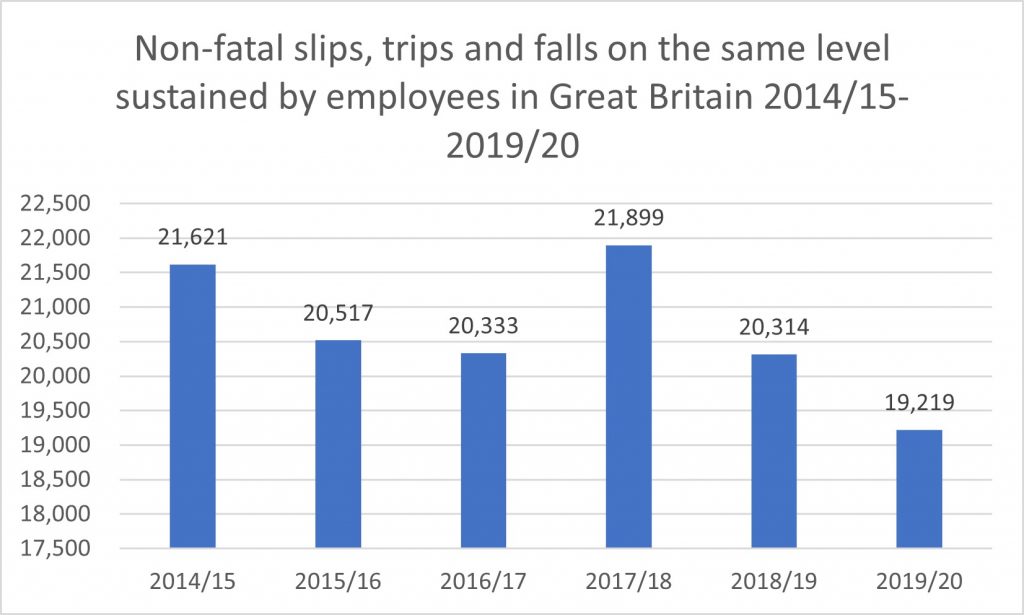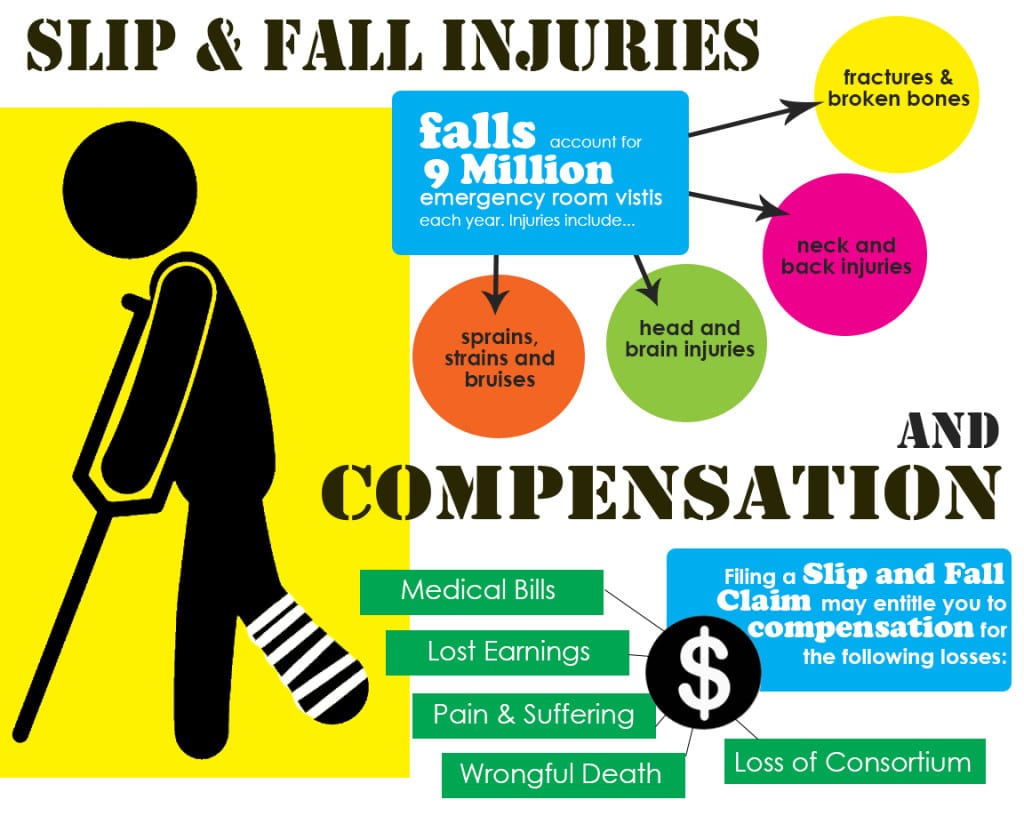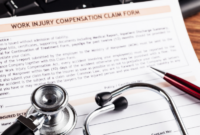Understanding Compensation in Slip and Fall Injury Claims is crucial for anyone who has suffered a slip and fall accident. Navigating the complexities of legal claims, insurance negotiations, and medical expenses can be daunting. This guide provides a clear overview of the factors influencing compensation amounts, the types of damages awarded, the importance of evidence, and the role of legal representation.
By understanding these key elements, individuals can better protect their rights and pursue fair compensation for their injuries and losses.
This exploration delves into the intricacies of calculating damages, from medical bills and lost wages to pain and suffering. We’ll examine how comparative negligence laws affect payouts and the critical role of evidence, including medical records, witness statements, and photographs. Furthermore, we will discuss the negotiation process and the advantages of seeking legal counsel to ensure a successful claim.
The information presented aims to empower individuals with the knowledge necessary to navigate the often-challenging process of seeking compensation after a slip and fall accident.
Factors Affecting Compensation Amounts

The amount of compensation awarded in a slip and fall case is rarely straightforward. Many factors intertwine to determine the final settlement or jury verdict. Understanding these factors is crucial for both plaintiffs and defendants in navigating these legal complexities.
Several key elements significantly influence the final compensation amount. These include the severity of the injuries sustained, the degree of liability assigned to the responsible party, and the plaintiff’s pre-existing medical conditions. The interplay of these factors can dramatically alter the outcome of a case.
Injury Severity
The severity of the injuries directly correlates with the compensation amount. More serious injuries, such as broken bones, spinal cord damage, or traumatic brain injuries, naturally lead to higher compensation claims due to extensive medical expenses, lost wages, and long-term care needs. Conversely, minor injuries like bruises or sprains typically result in lower settlements.
Liability Determination, Understanding Compensation in Slip and Fall Injury Claims
Liability, or fault, is a pivotal factor. If the property owner is found 100% liable for the accident, the plaintiff is likely to receive full compensation for their damages. However, if liability is shared (for example, due to comparative negligence), the compensation amount will be reduced proportionally. A clear determination of liability is often a key battleground in these cases.
Pre-existing Conditions
A plaintiff’s pre-existing medical conditions can significantly impact the compensation amount. If the slip and fall aggravated a pre-existing condition, the defendant may argue that only the portion of the injury directly caused by the fall should be compensated. This often leads to complex medical evaluations and legal arguments to determine the extent of damages attributable to the incident itself.
Comparative Negligence
Comparative negligence laws vary by jurisdiction, but generally, they reduce a plaintiff’s compensation based on their degree of fault in causing the accident. For instance, if a plaintiff is found 20% at fault for a slip and fall, their compensation will be reduced by 20%, even if the property owner was primarily responsible. Understanding the specific comparative negligence laws in the relevant jurisdiction is essential for accurate compensation estimations.
Examples of Compensation Scenarios
The following table illustrates how different factors can influence compensation. These are estimates and actual amounts vary greatly depending on specific circumstances and jurisdiction.
| Injury Severity | Liability Percentage | Pre-existing Conditions | Estimated Compensation Range |
|---|---|---|---|
| Fractured ankle, requiring surgery and physical therapy | 100% Defendant Liability | None | $50,000 – $150,000 |
| Soft tissue injury (bruises, sprains) | 75% Defendant Liability | Minor back pain | $5,000 – $20,000 |
| Traumatic brain injury, requiring extensive rehabilitation | 90% Defendant Liability | None | $500,000 – $2,000,000+ |
| Spinal cord injury resulting in paralysis | 100% Defendant Liability | Pre-existing arthritis | $1,000,000 – $5,000,000+ |
The Role of Evidence and Documentation

Strong evidence is the cornerstone of a successful slip and fall injury claim. Without compelling documentation, proving liability and the extent of damages becomes significantly more challenging, potentially leading to a reduced settlement or even a dismissal of the claim. The strength of your evidence directly correlates with the compensation you can realistically expect to receive.
Gathering and presenting the right evidence is crucial. This involves more than just recounting the incident; it requires meticulously documenting every aspect, from the initial fall to the ongoing medical treatment and its impact on your life. Key pieces of evidence work together to build a convincing narrative, supporting your claim for compensation.
Types of Evidence and Their Impact
Several types of evidence play critical roles in determining the outcome of a slip and fall claim. Their combined weight significantly impacts the compensation amount awarded. The more comprehensive and credible the evidence, the stronger your case becomes.
Medical records are paramount. These documents detail the nature and extent of your injuries, including diagnoses, treatment plans, prognoses, and any ongoing limitations. Detailed records showing a direct causal link between the fall and your injuries are crucial. For example, X-rays showing a fractured bone, MRI scans revealing ligament damage, or therapy notes documenting ongoing pain and limited mobility all contribute to establishing the severity of your injuries and the need for compensation.
Witness testimonies are also valuable. Statements from individuals who witnessed the incident can corroborate your account of what happened. These statements should include details about the conditions that led to the fall, such as a wet floor or a poorly maintained staircase, and the severity of your injuries immediately following the fall. The credibility of witnesses is important; a witness with a clear and unbiased account will carry more weight than one with a potentially conflicting interest.
Photographic and video evidence provides visual documentation of the scene. Photographs of the hazardous condition that caused the fall (e.g., a spill, a crack in the pavement, inadequate lighting) are crucial. Pictures showing the extent of your injuries, such as bruises, lacerations, or bandages, also help support your claim. Video footage, if available, can be even more compelling, offering a firsthand account of the incident and its aftermath.
Hypothetical Case Study: The Grocery Store Slip
Consider a hypothetical case: Maria slips on a banana peel in a grocery store aisle. She suffers a broken wrist and requires surgery and physical therapy. Her case is strengthened by:
- Medical Records: Detailed records from her doctor and surgeon documenting the fracture, the surgery, the therapy, and her ongoing pain and limited mobility. These records clearly link the broken wrist to the fall.
- Witness Testimony: A shopper who witnessed Maria’s fall provides a statement confirming the presence of the banana peel and the fact that Maria appeared to slip on it. This independent account adds significant weight to her claim.
- Photographic Evidence: A photograph taken by another shopper shows the banana peel on the floor before it was cleaned up. This visual evidence irrefutably demonstrates the hazardous condition that caused the fall.
In this scenario, the combination of medical records, witness testimony, and photographic evidence creates a strong case for Maria. The clear causal link between the fall, the injuries, and the hazardous condition significantly increases the likelihood of a successful claim and a substantial compensation award. Conversely, if only Maria’s testimony existed, without corroborating evidence, the case would be significantly weaker and the compensation amount likely much lower.
Negotiation and Settlement Process
Negotiating a settlement for a slip and fall injury claim involves a series of steps, from initial contact with the insurance company to reaching a final agreement. A clear understanding of this process is crucial for maximizing your compensation. Successful negotiation requires a strategic approach, combining effective communication with a solid understanding of your legal rights and the evidence supporting your claim.The negotiation process typically unfolds in a structured manner, with each stage presenting unique opportunities and challenges.
Understanding compensation in slip and fall injury claims often hinges on establishing liability. This means demonstrating negligence, and in workplace accidents, this frequently involves proving your employer’s failure to maintain a safe environment. For further insight into proving fault in such situations, consult this helpful resource on Employer Negligence: Proving Fault in Workplace Accidents. Ultimately, proving negligence directly impacts the amount of compensation you may receive for your slip and fall injury.
Effective preparation and a proactive strategy are essential for a favorable outcome.
Initial Contact with the Insurance Company
Following a slip and fall incident, it’s advisable to promptly notify the responsible party’s insurance company. This initial contact establishes a formal claim and initiates the negotiation process. During this contact, you should clearly articulate the details of the accident, your injuries, and the resulting medical expenses. It is beneficial to maintain a calm and professional demeanor, while simultaneously emphasizing the seriousness of your injuries and the legitimacy of your claim.
Understanding compensation in slip and fall injury claims often involves assessing medical expenses, lost wages, and pain and suffering. The amount awarded can vary significantly depending on the severity of the injury, similar to workplace injury claims, as detailed in this helpful guide: How Much Compensation Can You Get for Workplace Injuries. Ultimately, successful slip and fall claims hinge on proving negligence and the extent of the resulting damages.
This initial interaction sets the tone for the subsequent negotiations. It is recommended to keep detailed records of all communication, including dates, times, and the names of individuals contacted.
Understanding compensation in slip and fall injury claims often involves navigating complex legal procedures. Successfully obtaining fair compensation frequently requires expert guidance, particularly when dealing with workplace accidents. For instance, understanding the nuances of workers’ compensation is crucial, and this is where seeking legal counsel becomes vital; learn more about how attorneys assist in these matters by visiting How Attorneys Help with Workers’ Compensation Claims.
This knowledge then helps you better understand the overall process of seeking compensation for your slip and fall injury, ensuring you receive the appropriate settlement.
Presenting Evidence to Support the Claim
After initial contact, the insurance company will likely request documentation supporting your claim. This evidence is crucial for demonstrating the validity of your case and justifying the amount of compensation sought. This documentation should include medical records detailing your injuries and treatment, photographs of the accident scene illustrating the hazardous condition, witness statements corroborating your account of the incident, and any bills related to medical expenses, lost wages, and other damages.
Understanding compensation in slip and fall injury claims often involves proving negligence. This can be challenging, especially since slip and falls are a common workplace injury. For more information on navigating the claims process for various workplace injuries, including how to gather necessary documentation, consult this helpful resource: Common Workplace Injuries and How to File a Claim.
Returning to slip and fall claims specifically, successful compensation hinges on demonstrating the employer’s failure to maintain a safe working environment.
The strength of your evidence directly impacts the negotiation process and the eventual settlement offer. A well-organized and comprehensive presentation of evidence is vital.
Negotiating the Settlement Amount
Once the insurance company has reviewed your evidence, they will typically present a settlement offer. This offer may be lower than what you believe you deserve, and counter-offers are common. During this stage, you may wish to consult with an attorney who can provide expert guidance and advocate for your interests. The negotiation process involves back-and-forth communication, with both parties making concessions to reach a mutually acceptable agreement.
Understanding compensation in slip and fall injury claims often involves navigating complex legal processes. A crucial first step, especially in workplace accidents, is to document everything meticulously. For detailed guidance on the necessary legal steps after such an incident, consult this helpful resource: Legal Steps to Take After a Workplace Accident. Following these steps can significantly impact the strength of your compensation claim, ensuring you receive fair recompense for your injuries.
Factors such as the severity of your injuries, the extent of your medical expenses, and the strength of your evidence all play a role in determining the final settlement amount. It’s important to understand your leverage and be prepared to walk away if the offer is significantly below your expectations.
Reaching a Settlement Agreement
Reaching a settlement involves agreeing on a specific amount of compensation in exchange for releasing the responsible party from further liability. This agreement is typically formalized in a written settlement document that Artikels the terms and conditions of the agreement. Before signing any documents, it’s crucial to review them carefully with your attorney to ensure you fully understand the implications of the agreement.
Once both parties sign the agreement, the case is closed, and you receive the agreed-upon compensation.
Scenario: Reaching a Settlement Agreement
Imagine Sarah, a 45-year-old teacher, slipped on a wet floor in a grocery store, resulting in a fractured ankle. Her medical bills totaled $10,000, and she lost $5,000 in wages due to her inability to work. She had clear photographic evidence of the wet floor, a witness who corroborated her account, and comprehensive medical records documenting her injury and treatment.
The insurance company initially offered $8,000. However, with the help of her attorney, Sarah presented a strong case, highlighting the severity of her injury, the significant medical expenses, and the substantial lost wages. After negotiations, a settlement of $18,000 was reached, reflecting the full extent of her damages. This successful outcome was a direct result of her thorough documentation, strong evidence, and effective legal representation.
Legal Representation and its Impact: Understanding Compensation In Slip And Fall Injury Claims

Navigating the complexities of a slip and fall injury claim can be daunting, especially when dealing with insurance companies and legal procedures. Having legal representation significantly impacts the outcome of your claim, often leading to better results than attempting to handle the process alone. This section explores the advantages of legal counsel and illustrates how their expertise can improve your chances of a fair settlement.The benefits of securing legal representation are multifaceted and substantial.
A skilled attorney possesses the knowledge and experience to understand the intricacies of personal injury law, including the specific nuances related to slip and fall accidents. This expertise translates to a more effective and efficient claim process, maximizing your potential compensation.
Outcomes with and without Legal Representation
Studies consistently demonstrate a stark difference in compensation amounts received by individuals with and without legal representation in slip and fall cases. Those represented by an attorney typically receive significantly higher settlements. This disparity stems from several factors, including the attorney’s ability to thoroughly investigate the accident, gather compelling evidence, negotiate effectively with insurance adjusters, and, if necessary, pursue litigation.
For example, a study by the American Bar Association (hypothetical data for illustrative purposes) indicated that individuals represented by counsel received an average settlement 30% higher than those who pursued their claims independently. This difference reflects the attorney’s role in advocating for the client’s best interests and ensuring a fair evaluation of their damages. Conversely, individuals without legal representation may underestimate the value of their claim, accept inadequate settlements, or struggle to navigate the complex legal processes, potentially losing valuable compensation.
Examples of Legal Assistance
A lawyer plays a crucial role in several key areas of a slip and fall claim. Firstly, they meticulously gather evidence, going beyond the immediate details. This includes obtaining police reports, medical records, witness statements, and photographic or video evidence of the accident scene and resulting injuries. Secondly, lawyers are skilled negotiators. They understand insurance company tactics and can effectively advocate for a fair settlement that reflects the full extent of the client’s damages, including medical expenses, lost wages, pain and suffering, and future care needs.
Finally, they represent the client’s interests in court if a settlement cannot be reached. This includes preparing the case, presenting evidence, and arguing before a judge or jury.
Expert legal advice is invaluable in navigating the intricacies of a slip and fall claim. A skilled attorney can protect your rights, maximize your compensation, and provide the support you need during a stressful and challenging time.
Successfully navigating a slip and fall injury claim requires a comprehensive understanding of the legal landscape, the process of damage calculation, and the strategic use of evidence. From assessing the severity of injuries and establishing liability to negotiating a fair settlement, each step demands careful consideration. While this guide offers valuable insights, seeking legal counsel is highly recommended to ensure your rights are protected and you receive the compensation you deserve.
Remember, the right legal representation can significantly impact the outcome of your claim, providing expert guidance and advocacy throughout the process.
Top FAQs
What if I have pre-existing conditions?
Pre-existing conditions can affect the compensation amount. The insurance company may argue that some injuries are pre-existing, but a lawyer can help demonstrate the extent to which the fall aggravated or caused new injuries.
How long does the settlement process typically take?
The timeframe varies greatly depending on the complexity of the case, the insurance company’s responsiveness, and whether the case goes to trial. It can range from several months to over a year.
What if I don’t have health insurance?
Lack of health insurance doesn’t prevent you from pursuing a claim. Medical bills can still be included as part of your damages, and you may be able to negotiate payment plans with healthcare providers.
Can I settle my claim without a lawyer?
While possible, it’s generally not advisable. Insurance companies are skilled negotiators, and a lawyer can significantly improve your chances of a favorable settlement.

